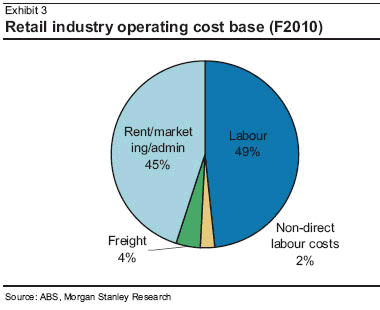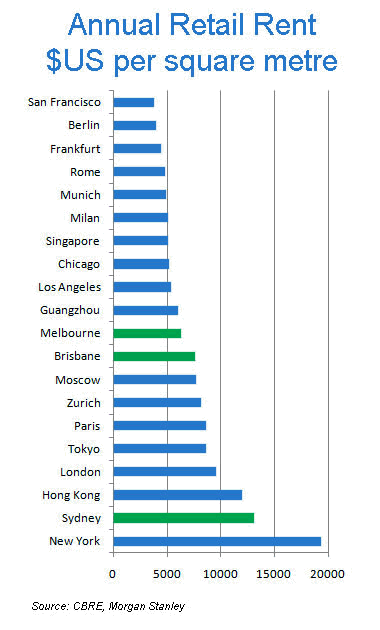As we head into a week where the US faces its debt crisis and Australia ponders the prospects of a severe non-mining downturn if the Reserve Bank raises interest rates, in the eye of the local storm is non-food retailing.
Non-food retailing, which employs 800,000 Australians, is in deep trouble. We are looking at the possibility of a big fall in the value of the billions invested in strip shopping centres and at extensive labour lay-offs. This is an enormous and fundamental change to our nation for which our banks, property owners, retailers and most of all, retail employees are not prepared.
At the same time, we are on the edge of a bizarre war in hardware, furniture and appliances because our largest and best-placed food retailer, Woolworths, has decided to invest hundreds of millions in new outlets as part of a massive drive into segments of non-food retailing to intensify competition at the time of the industry’s darkest hour.
The sheer horror of what is ahead in segments of non-food retailing was underlined at the weekend by the KGB interview with Premier’s retail boss Mark McInnes and is further detailed in a series of graphs prepared by my research assistant Alex Liddington-Cox using material assembled by Morgan Stanley.
During the weekend I walked up Rundle Mall in Adelaide and saw four empty shops (two have since been leased). The mall is one of hundreds around the country where investment has been restrained as landlords maximised rental income. Those centres are now struggling against modern, albeit high-rent, shopping centres. The troubled centres need lower rents and higher investment, which is a recipe for lower values.
Our first graph is sickening because it shows the enormous cost burden retailers face in Australia. About 49% of their operating costs is labour, which is between 25% and 30% more expensive than in most other developed countries. The new Fair Work rules and the higher Australian dollar will drive the Australian costs higher.

In the above graph we find that a massive 45% of operating costs are rent, marketing and administration. To determine just how much more Australian retailers pay for rent than their overseas counterparts, our second graph compares annual rent in 20 cities.

Sydney, as the world’s second most expensive retail rent city, is charging its retailers higher rents than Hong Kong and London. But Sydney does not match New York, although the recent rise in the Australian dollar may have bridged the gap, giving Sydney a real chance to be the world’s most expensive city for retail rents. That also makes it our most vulnerable.
Even Melbourne and Brisbane are more expensive than 10 other global cities. Retailing is a business that until now was insulated from the world and so developed labour and rental practices similar to highly protected societies. In the food sector that will remain, but in non-food the protection barriers have come down thanks to online shopping, so the rules are about to change. And that change will take place at a time when consumer demand is going to be depressed for the reasons we all know.
Our third graph comes from Australia Post and Morgan Stanley and shows that inbound postal items skyrocketed 28% on 2009-10. They almost certainly rose just as fast in 2010-11. This jump reflects internet imports.

I suspect postal imports will accelerate in the current year as the word spreads about the bargains available from global retailers, who pay a fraction of Australian labour and rent costs. The government may lift retail “protection” but the cost gap is too great for that to make much difference unless there is a massive protection increase.
Which takes us to our fourth graph, which shows the pricing difference between in-store and online goods.

The highest difference was in books, something that led to Angus & Robertson and Borders being wiped out. Only small specialised bookshops can survive that cost differential.
Then comes the core of modern department store retailing — cosmetics and fragrances — with a 44% cost difference between their international competitors. Home furnishing and appliances have a 43% cost differential. Hardware will also be not much better. None of the categories in this graph will be safe from the massive low-cost online competition that they will have to meet.
All of the non-food retail sectors are set to achieve substantially less growth than they have in the past. Some will go into negative territory. Sometimes the giants will wipe out the smaller groups but at the cost of margin.
It will not be a happy time for banks, property owners, non-food retailers and, most of all, retail employees.
*This article was first published on Business Spectator







Devastated by the lack of a new Firstdog cartoon in today’s Crikey…….. (sob)
Imagine my surprise, to find a replacement dose of humour from none other than Robert Gottliebsen! 😀
I know it’s only Monday, but this week’s prize for purple prose must surely go to…
[The sheer horror of what is ahead in segments of non-food retailing was underlined at the weekend by the KGB interview with Premier’s retail boss Mark McInnes…]
So why are labour costs such a high fraction ? My experience tells me the average retail worker is not on an especially high salary, especially in the context of Australia’s astronomical cost of living.
Three things, perhaps, could help retail:
1) Providing a better experience than online. Shop assistants that are knowledgable and actually care about helping you. Other services that are simply not available online without face to face contact. Often, small, independent stores have this–but the big chains? I avoid them like the plague.
2) Not over-charging customers. The internet sales represents nothing more than Australians realising just how much we are being barbarised and over-charged for goods. I prefer to buy some things locally (like clothes – I don’t know how you can just buy something without being sure it will fit comfortably), but for things like electronics or video games, the sheer price difference is utterly insane and there is absolutely no reason for it.
3) And probably the key one – greedy landlords not making a killing out of small business owners. The rent in some of these places is absolutely insane. If not for the humongeous rent prices, retailers could probably afford to do 1) and 2) without a problem. And that would attract sales back onshore.
‘The highest difference was in books, something that led to Angus & Robertson and Borders being wiped out.’
Very short memory, Robert- What about the minor matter of AUD140 million debt that Borders was spun off with? Borders might have made it under pre-GFC conditions, but those conditions didn’t last, did they?
Retailers are desperately seeking to pile blame for their sorry condition on the internet, rather than acknowledge that they have taken their consumers for granted. Robert seems eager to help them enhance their fiction.
Angus & Robertson and Borders were ‘wiped out’ because they were bought by highly leveraged private equity firms which couldn’t fund their very high borrowing costs.
One reason for high labour costs in in Australian retail is low investment in capital and consequentially low efficiency. Several medium sized shops in the UK such as pharmacies have automated check outs which Australian supermarkets are only now introducing.